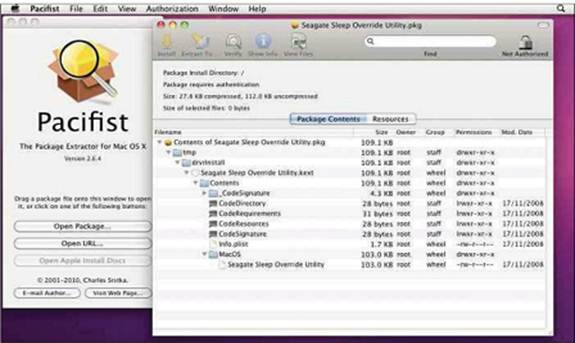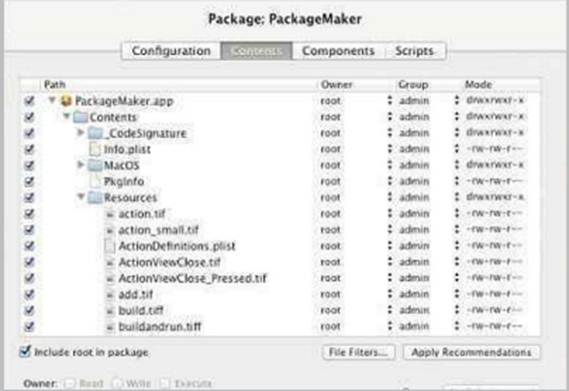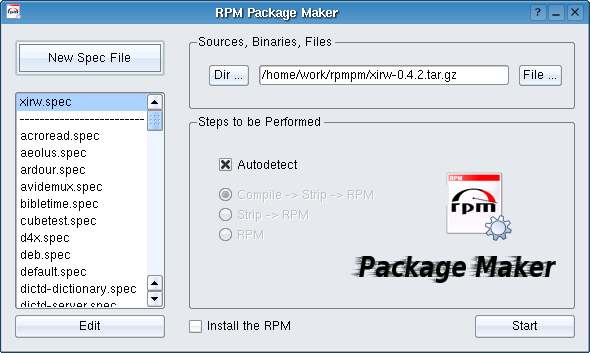The greatest anomaly in the use of filename
extensions is in files consisting of executable code, such as command shell
tools. Shell scripts normally have the extension .sh if they’re to be run in a
command shell, such as in the Terminal application, but are editable text
files. All executable code files, including background services, command tools
and even the code contained within applications are named without any
extension. This is to conform to standard UNIX practice, rather than the
Windows tradition of .exe and .com.

Driven is extraction. When you need to extract and install separate
components that are only available in a larger Installer Package, use Pacifist
For traditional Mac users who had come to
love freedom from the mechanical discipline of file naming conventions, the
rise of filename extensions may seem to be a sellout to the UNIX and Windows
world. In fact, these extensions enrich and enhance, and should only very
seldom trip you up once you understand their whys and wherefores. They’re
essential to maintaining the wonderful illusions worked by the Finder and OSX,
and keeping your work productive.

For normal purposes, the PackageMaker tool provided in Xcode is of limited
value, but it comes into its own if you create or modify packages
Inside a .app file
An application with the .app extension
seems, in the Finder, to be a single object with its custom icon for identification.
In fact, what you see is a pure illusion created by the Finder, as it’s really
a folder containing a fairly rigorous structure of sub-folders and files with
different functions. Select the application icon in a Finder window and
Ctrl-click to bring up the Finder’s contextual menu, which contains the Show
Package Contents command to open it as a folder.
At the top level, all applications folders
with the extension .app - contain a single wrapper folder named Contents.
Within that you’ll see an array of folders and documents that make up the
application. The executable code, one of the few files that doesn’t have an
extension, is tucked away inside the folder named MacOS. The Resources folder
contains those files that in Mac OS Classic would have been stored as
resources, in the resource fork of the application file. In that are graphics
and icon files for all the icons and other visual devices used by the
application, text, html and other content used by various windows, and .nib
documents created by Xcode’s Interface Builder; the latter are packaged
folders and can be opened further using the Finder’s contextual menu.
Applications with multi-lingual support
usually have separate .lproj folders containing localized resources for each
different language version (you can produce your own custom localized version
by adding such resources). Help files, DTDs, templates and defaults may also be
kept here. At the top level, Info.list is a mandatory XML property list
containing essential settings, including a listing of the document types
handled by the application. Pkglnfo holds the old Finder information, and the
Code-Signature folder supports new OS X security features.
Inside an installer package
Applications aren’t the only specialized
folder types that the Finder pretends are single objects: another common
subject for this trick is the installer package bearing the extension .pkg.
Common delivered in .dmg disk image files, which are a single file designed to
survive transmission over the internet, packages are another folder bundle with
a standard prescribed layout and contents. However, some packages are now
supplied as compressed archives that can’t be opened directly in the Finder
without decompression.

Developers
usually create them using PackageMaker, one of the utilities supplied as part
of Apple’s free but vast Xcode toolkit
Packages can be inspected using the
Installer’s Show Files... command in its File menu before you install the
contents, but Installer lets you do little other than install or sometimes
uninstall each package. Developers usually create them using PackageMaker, one
of the utilities supplied as part of Apple’s free but vast Xcode toolkit. You
can use PackageMaker to create your own installer packages, modify existing
packages and inspect but not unbundle components within a package. If you want
to install just part of a package - say, if you’ve inadvertently trashed or
damaged QuickTime Player or another component only supplied within a much
larger package - use Pacifist (charlessoft.com).
Like an .app, an installer package has a
single wrapper folder named Contents, within which are two property lists -
Info.plist and version.plist, the former containing the important settings for
the package. The items to be installed are supplied in Archive.pax.gz or
similar, a compressed archive that has the same folder structure as the one in
which they’ll be installed on your Mac. Archive.bom is a ‘bill of materials’
listing of the contents, which will be placed in the boms folder in
/Library/Receipts and form the material used for checking and repairing preferences.
The Resources folder contains all the tools and scripts needed to run the
installation within the Installer application.